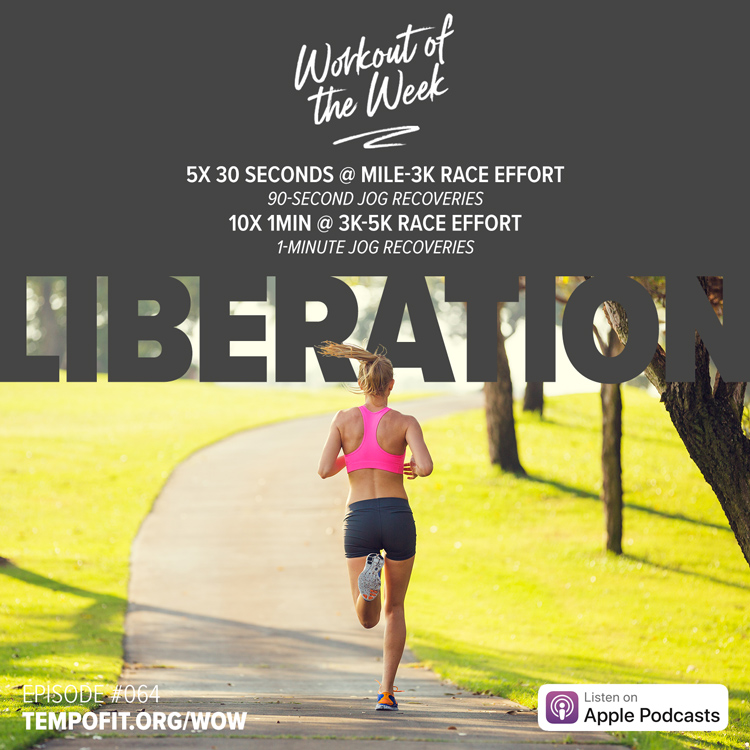
It’s the silly season, so what better time to do a fartlek session where you switch off the GPS and loosen the reins so you can run how you feel, fast and free!?
WHAT?
5x 30 seconds @ your 3k to mile race effort (90 seconds recovery jogs)
10x 1 minute @ your 5k to 3k race effort (1 minute recovery jogs)
Terrain: Flat to undulating pathway predictable under foot.
Feels: Liberation!
Remember, a fartlek session is designed to free you up to run as you feel and not be constrained by splits and exact paces. So switch the GPS off and enjoy tuning into the inner workings of your body as you run fast and free.
WHY?
As runners we can’t always be slaves to the stopwatch or to Strava. We need times when we can run by feel, either easier (because of a hard week of training or stressful life situations) or faster (because we’re feeling fresh and wanting to get after it).
This sort of training does what the body and mind requires, and not just what we assume it needs.
HOW?
As with most fartlek sessions, aim to keep this off a running track. But, because you’re running fast, you do want to make sure you’re not on super hilly terrain or that the surface is unpredictable. So, crushed limestone or fine gravel or smooth grass like a playing field or golf course are all ideal surfaces.
THOUGHT FOR THE WEEK:
DEALING WITH DISAPPOINTMENT
By Hayden Shearman
Last week I had a disappointing workout where I hit my splits but it was WAY harder than I was hoping. Likewise, my running journey has been dotted with disappointments like injuries, missed goals and training setbacks.
I’m sure you’ll be able to reflect on many yourself. And perhaps you’ve recently experienced a running disappointment. So, how can you deal with these? And can you spin them around with the whole “what doesn’t kill makes me stronger” philosophy? Here are four tips …
1. Expect down days. Running improvement is never linear. By definition, physical fitness goes in cycles where you introduce a stress, which makes you “less fit” temporarily, then your body adapts, and you end up stronger. So it makes sense that many running disappointments just happen to coincide with one of these training dips—it can be a simple case that a week later you probably would have run amazingly. Add to this sickness, life stress, hormones, weather conditions, competition elements, gear malfunctions, blisters, chaffing, bleeding nipples and so on … and you’ve got a whole host of things that make the runner’s journey even more of a rollercoaster. It’s all part of the fun!
2. Understand why it occurred. I’m a big one for reflecting on and analysing all of my races and workouts. What worked? What didn’t? There are always things to learn. And if you can’t spot the issue, grab a coach and/or a doctor who can approach things from a different perspective. Sometimes a blood test after a surprisingly disappointing race can reveal all sorts of unseen health issues. And a coach can help identify when there’s a cluster of small 0.1% issues that compound to leave your just off your game on race day.
3. Learn to predict & prevent these issues. Once you’ve done this analysis, then come up with a game plan to lessen the chances of these issues impacting you in future. A big one for many is understanding what sort of taper works best. Some people just need a week of light mileage before a half or full marathon; others need several weeks. Same for food before a race: you’ve got to play around with what works for you.
4. Don’t just run! Finally, I can’t stress enough how important it is to not just have running in your life. With such an all-consuming and rewarding sport, it can be easy to wrap up our identities in running, only to have our worlds come crashing down through injury or missing a Boston Qualifier time.
So, never lose sight of investing time and energy into family, friends, work, other hobbies and your spiritual and mental health. And, when it comes to exercise, make sure you always have a non-running exercise that you enjoy and do regularly even in the midst of high-mileage running training. Surfing, cycling, yoga, golf, swimming … whatever it is, make sure it’s in place as a regular lifestyle choice before you’re forced to lean on it when injury or sickness arrives.
Podcast (workout-of-the-week): Play in new window | Download
Subscribe: Apple Podcasts | RSS | More



